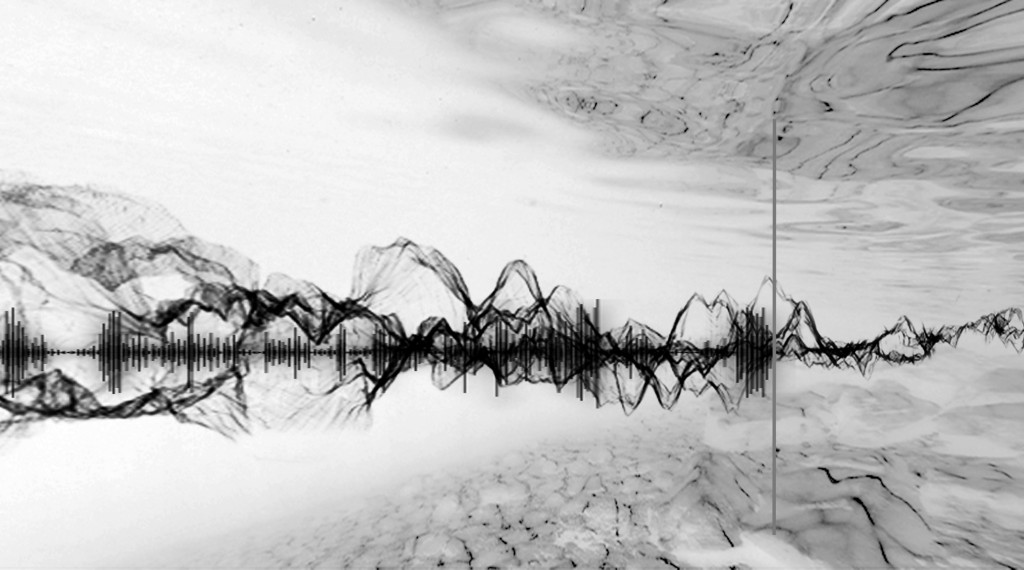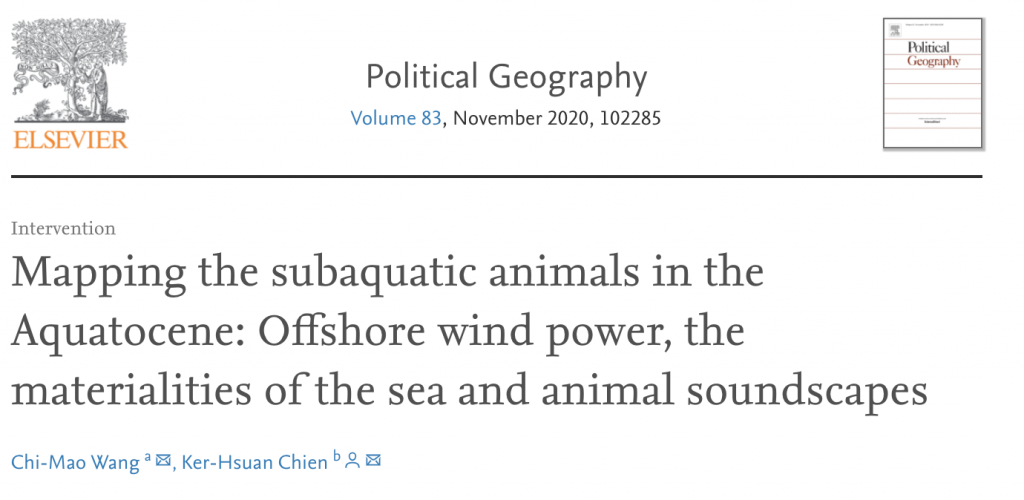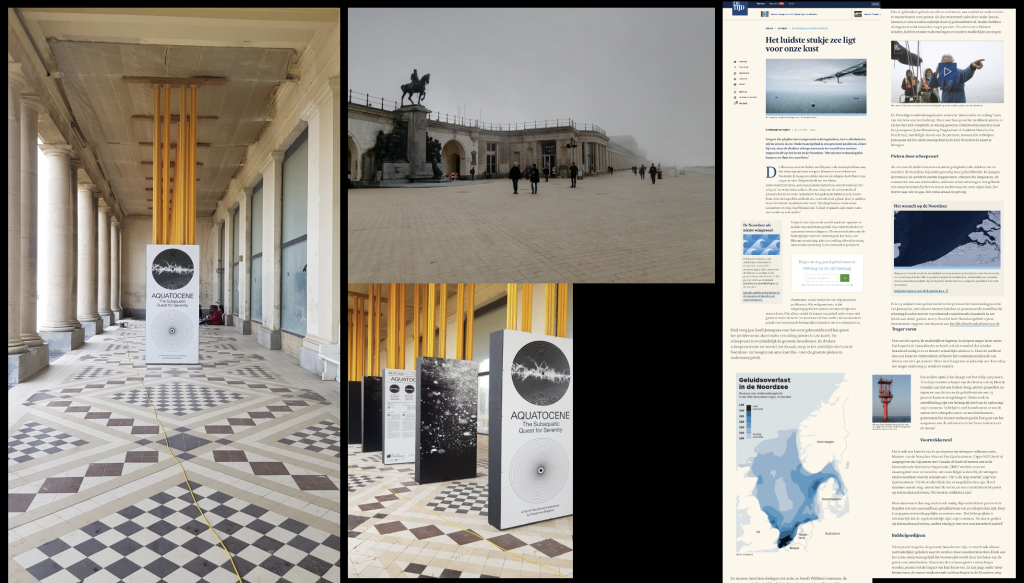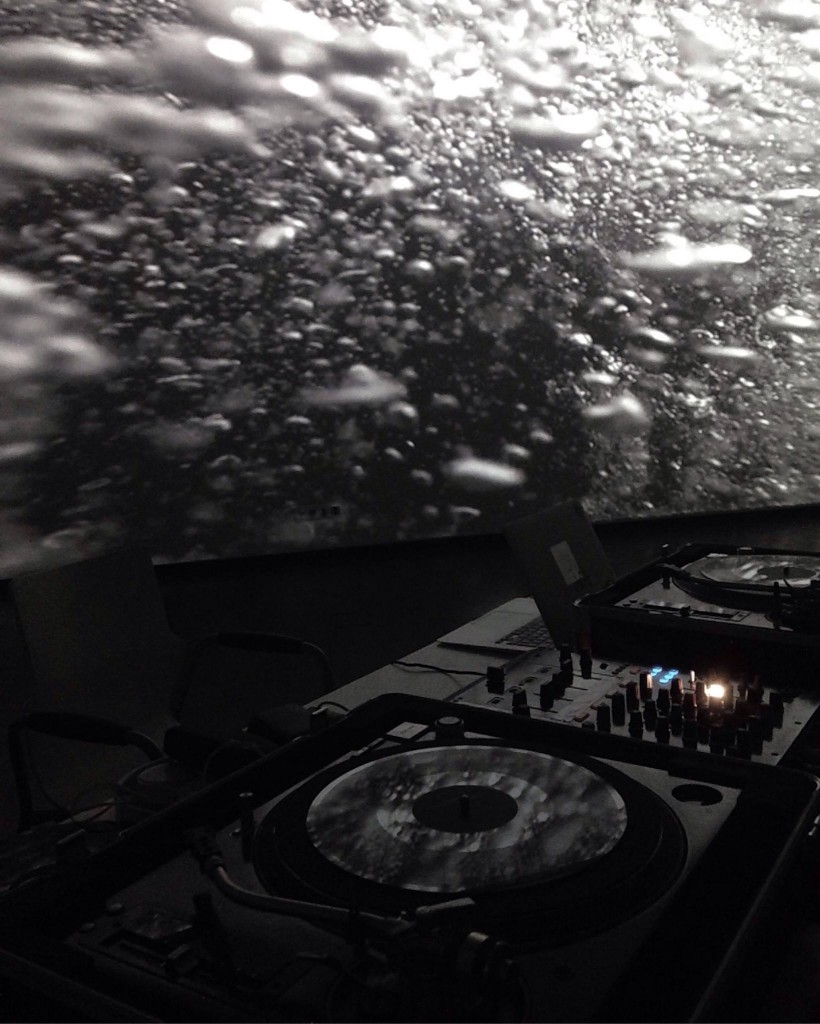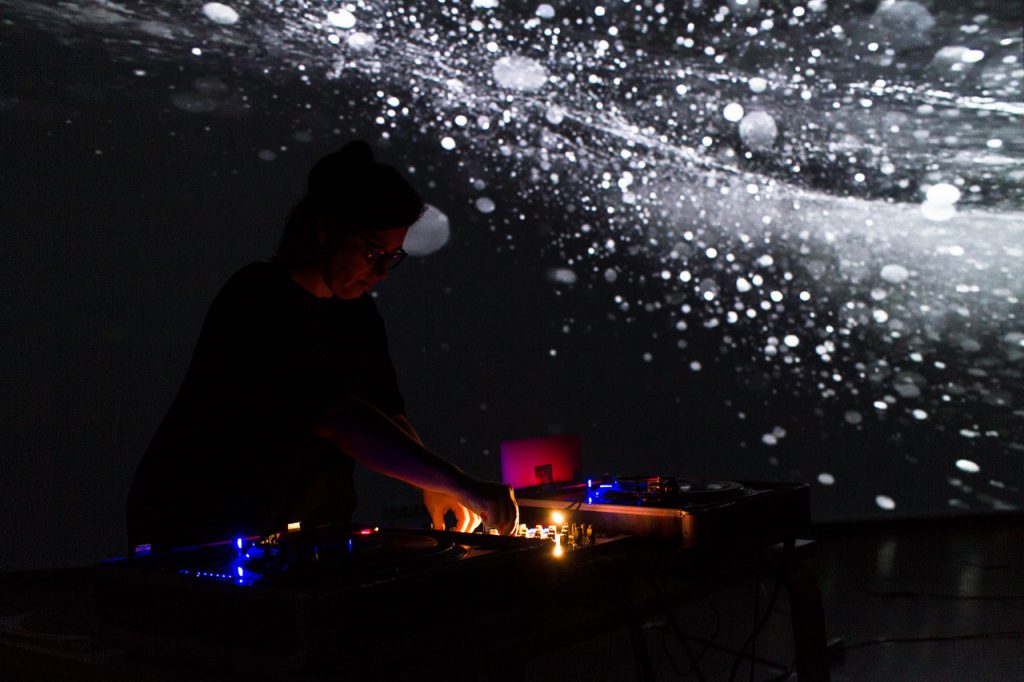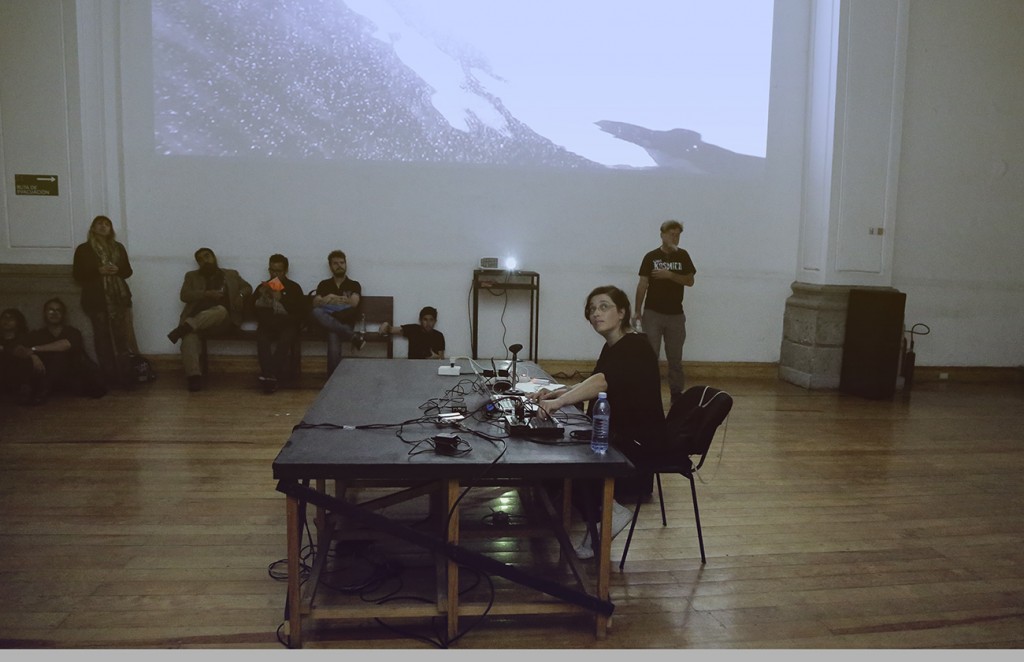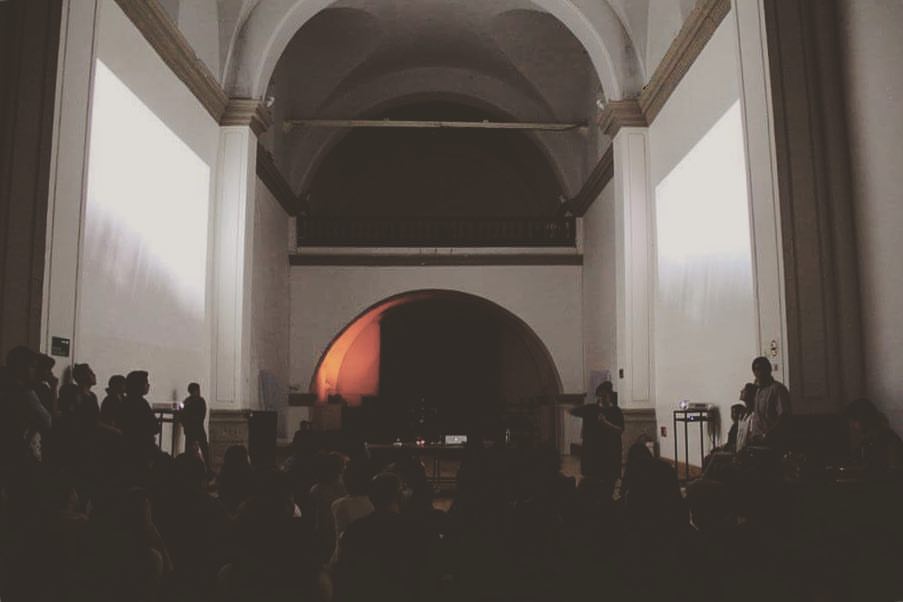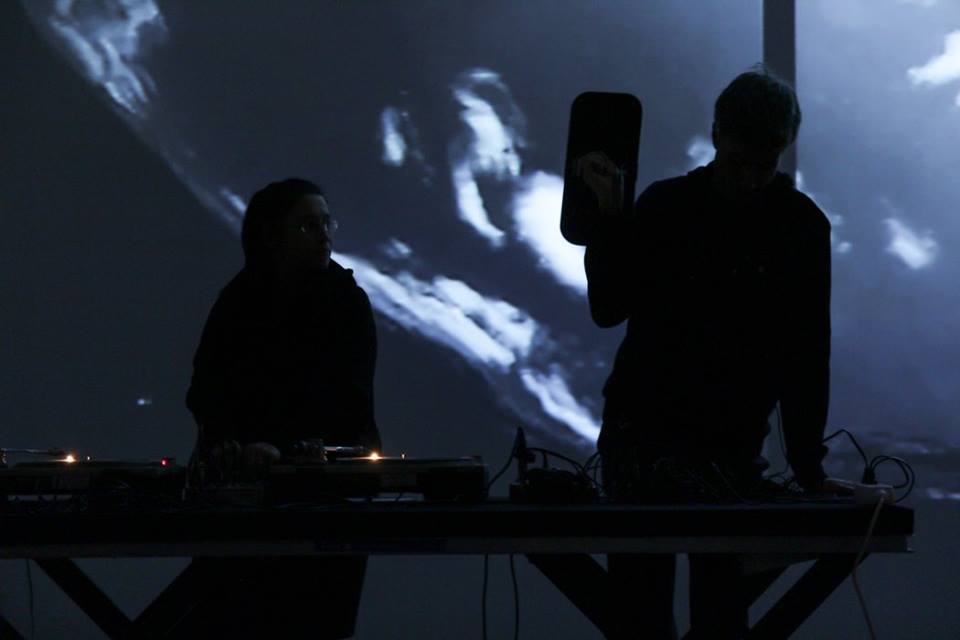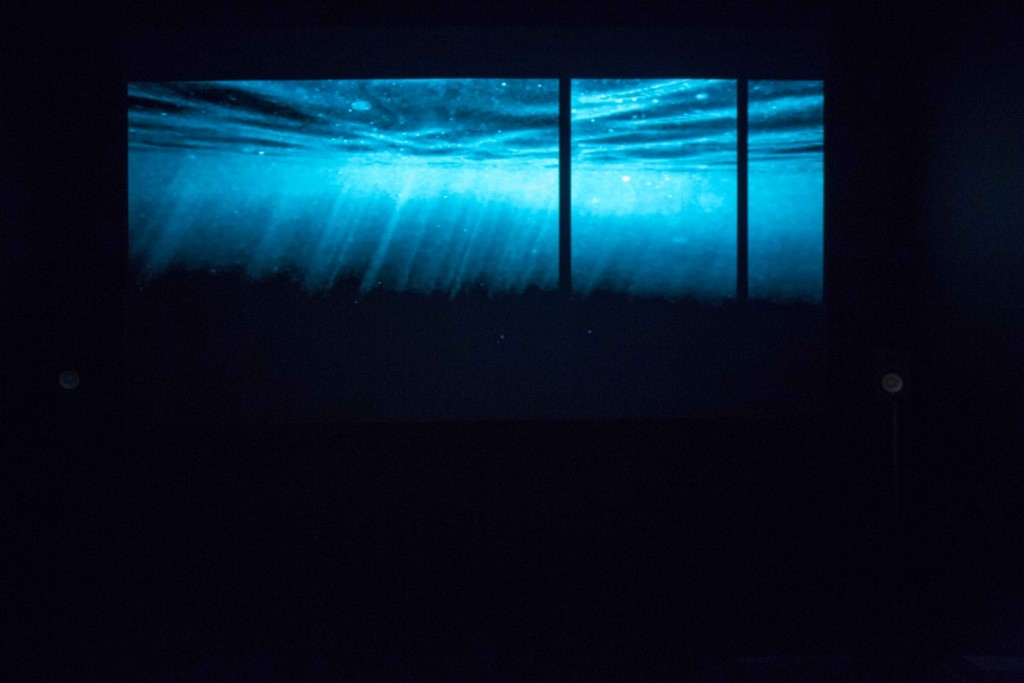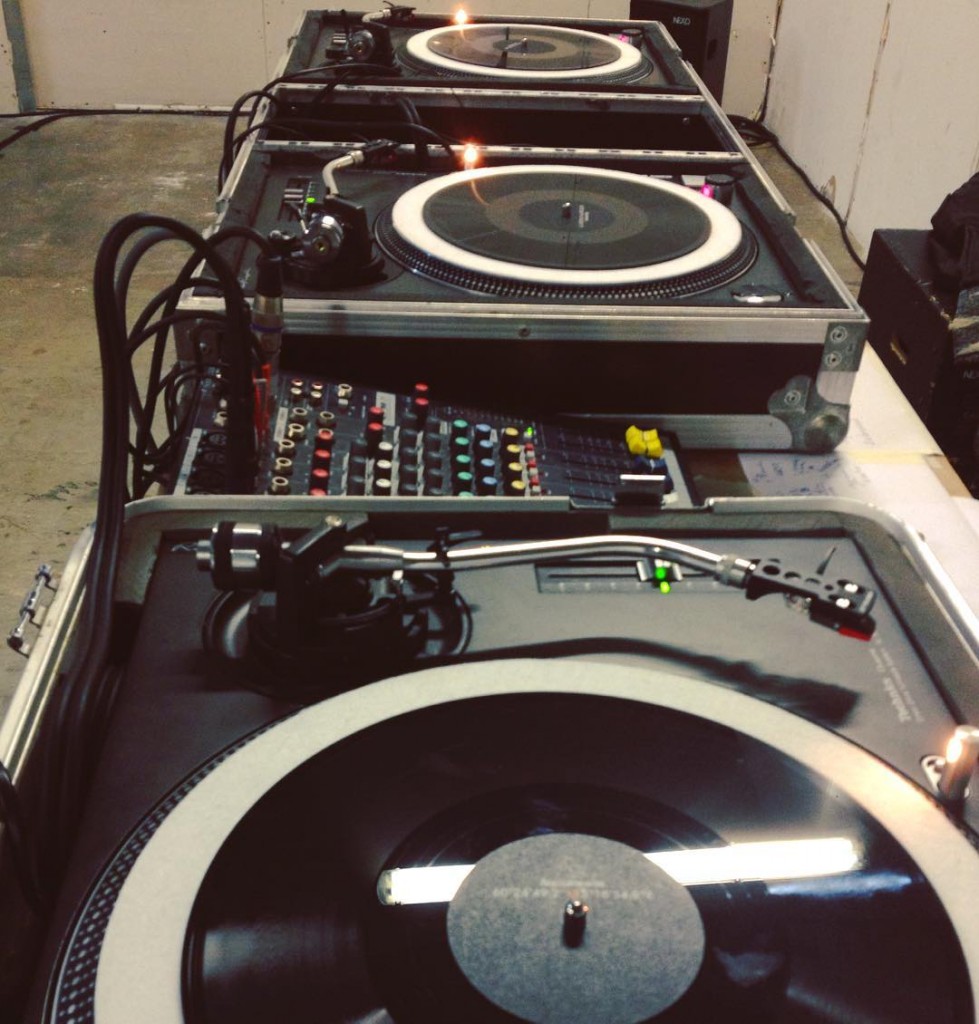Aquatocene / Subaquatic quest for serenity
by Robertina Šebjanič
since 2016 – ongoing project
Aquatocene / V iskanju podvodne tišine [slovenski tekst ⇊⇊]
The audio compositions of the subaquatic soundscape encourage us to reflect upon the anthropogenic sonic impact on the underwater habitat and marine life, as well as illuminate awareness and underscore the importance of maintaining safe sound environments for animals living in the world’s oceans, seas, lakes and rivers.
Aquatocene at bandcamp: https://robertina.bandcamp.com/album/aquatocene-subaquatic-quest-for-serenity
»Aquatocene / The subaquatic quest for serenity« investigates the phenomenon of underwater noise pollution created by humankind in the seas and oceans. The sound compositions are a re-mix between the bioacoustics of marine life (shrimps, fish, sea urchins etc.), the aquatic acoustics and the presence of human generated noise in the world’s oceans and seas.
Over the last few years Robertina has made a number of recordings using hydrophones in different locations around the globe. Underwater noise effects a great number of marine life forms which depend on the sub-aquatic sonic environment to survive.
Aquatocene soundscape compositions had been recorded:
Aquatocene – 38°26’24.7″N 27°07’12.9″E _Aegean Sea – Izmir (TR)
Aquatocene – 42°38’26.5″N 18°06’20.4″E _Adriatic Sea – Dubrovnik (HR)
Aquatocene – 42°57’31.62″N 17°8’12.08″E _Adriatic Sea – Korčula (HR)
Aquatocene – 45°32’54.9″N 13°42’20.1″E _Adriatic Sea – Koper (SI)
Aquatocene – 48°43’38.2″N 3°59’33.4″W _Atlantic Ocean – Roscoff (FR)
Aquatocene – 53°10’16.3″N 9°34’51.3″W _North Atlantic Ocean – near Galway (IE)
Aquatocene – 53°19’37.3″N 5°07’18.5″E _Wadden sea – Vlieland (NL)
Aquatocene – 60°24’49.2″N 5°16’54.9″E _North Sea – Bergen (NO)
and many more….
Despite the broad availability of popular aquatic sounds, we aren’t really aware that the underwater soundscape is as rich as the one heard by terrestrial creatures above water. Aside from lacking experience in terms of the fascinating diversity of marine sound, we are also not aware that sonic pollution caused by humans is already changing the soundscape of the waters and even the communication of its inhabitants.
When we look up to the sky, look into space and wonder about what is up there we sometimes forget that there is still a lot left for us to explore on the planet we live on. We know more about space than we know about the world’s seas and oceans, especially when it comes to sound perception underwater. We are usually unaware of the vibrant underwater acoustics, the sounds of the ocean’s depths. Our familiarity with these sounds is usually limited to the sound of a wave crashing into land. Whales, shrimp, seals, dolphins, and a variety of other creatures of the deep live in a watery sonic environment.
Technological interventions into the ocean soundscape by ships, sonars and sound cannons (used in oil exploration) can create huge disturbances in fragile marine habitats and have been connected to a number of effects ranging from the beaching of whales to the »Lombard effect« where certain species themselves become louder to overcome background noise, thereby gradually increasing the intensity of the entire habitat.
Water habitats cover over 70% of the Earth’s surface. 97% of the world’s water is saltwater, 2% is fresh water in the form of ice and only the remaining 1% is drinking water, which is distributed around the planet very unevenly. The exploration of an ecosystem requires detailed study and observation. The ocean is the most complex, challenging, and harsh environment on Earth and accessing it requires specially designed tools and technology. The technological advances have finally reached the point 50 years ago that enables us to examine the ocean in a systematic, scientific, and non invasive way. Our ability to observe the ocean’s environment and its resident creatures has finally caught up with our imaginations and helped us to understand it in ways we could not even envision them before.
The lively sound image of the underwater environments, rivers, lakes, seas and oceans still represents the big unknown for the majority. In recent decades, advanced tools and the latest technology enabled us to explore underwater environments in a systematic, scientifically relevant and non-invasive way. We are thus able to identify the anthropogenic disturbances and noise that affect the underwater environment, as well as analyze their impacts.
Robertina Šebjanič (turntables, electronics). Video taken on 20th December 2020 at Osmo/za, Ljubljana. Live visualization and real-time video editing by Stella Ivšek (5237). Camera and real-time live stream by Adam Mulalić and Črt Trkman. Sound engineered and recorded by Črt Trkman. Post production by Tea Grahek. Event organized by KUD Mreža / FriForma.
Vestibular S. Observatory – Robertina Šebjanič & Arnout Meijer
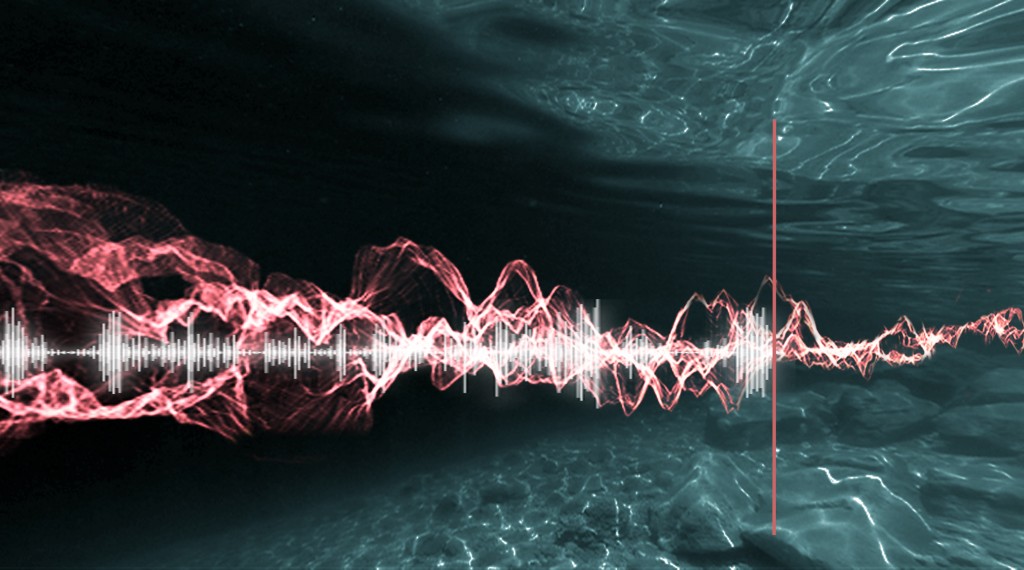
Aquatocene – Aural Interception of a Troubled (Subaquatic) World
by Robertina Šebjanič
(first published in the The Universal Sea – The art and innovation guide against the plastic epidemic, March 2019 )
Sound is the main communication tool for most marine animals and plants that dwell in the deep darkness of the world’s oceans and seas. Despite widespread knowledge of certain aquatic sounds, like those produced by animals such as whales, the public is predominantly not aware that the underwater soundscape is as rich as our terrestrial one.
Beyond lacking experience of the diversity of marine sounds, people are often uninformed about the fact that sonic pollution caused by humans has already profoundly changed the soundscape of waters, to the point where natural communication of marine animals is being largely disturbed. Today, man-made noise causes severe disruptions in subaquatic habitats with huge consequences for marine life.
With the audio compositions of subaquatic soundscape, the Aquatocene project reflects upon the anthropogenic sonic impact on the underwater habitat and marine life as well as it raises awareness and underscores the importance of preserving safe sound environments for animals living in the world’s oceans, seas, lakes and rivers.
In the past couple of years I have spent a lot of time on the sea researching the impact of man-made noise on underwater habitats. I have been working in the Mediterranean Sea, Adriatic Sea, North Sea, and Atlantic Ocean, using hydrophones (underwater microphones).
For most of the people being next to the sea, swimming in the water and relaxing on the shore, the presence of water triggers a sense of serenity. It was the same for me, but this changed dramatically when I started to record underwater sounds. The extent to which the sound penetrates into water habitats completely surprised me. It turns out that nowadays man-made noise is undoubtedly omnipresent in the subaquatic environment.
My expectations of underwater serenity were fundamentally challenged. Everything else was present except the silence. Sound travels across water much faster and also much further than, for instance, across air, which is also the reason why sound is the main communication tool for so many marine species. Light is only present on the very surface of the sea (in the upper 200 meters) while in deeper areas light disappears and gradually turns into deep darkness.
The human presence manifested through technological devices such as boats, sonars and sound cannons (when looking for oil) is most often highly disturbing for animals. It scares and confuses them while navigating across the ocean. These invasive sounds can easily overpower their communication abilities and therefore animals try to avoid them, often with drastic consequences.
These facts encouraged me to begin an ongoing investigation into subaquatic sound pollution. Field recordings capturing underwater sounds began in 2014 during my residency in Izmir, Turkey, where I took part at the Port Izmir triennial, curated by Saša Nabergoj and organised by K2. My aim was to record the sounds from swarms of jellyfish in the Gulf of Izmir. In the beginning I tried to delete the “techno presence” of man-made sounds which have been present in most of the recordings. But the more I recorded and listened to the material, the more I realized that man-made noise is the sonic reality of today’s ocean – in the same way as it dominates the terrestrial soundscape.
When recording with hydrophones and preamplifiers I try to practice a non-invasive way to interact with marine life. Therefore I also conduct workshops on how to build DIY hydrophones through which I tend to bring pressing issues of ecology closer to the wider public. Dropping a hydrophone into water during workshops is always an eye-opening moment for participants when they experience the scale of underwater sounds.
My artistic practice exists on the intersection of cultural, (bio)political, chemical and biological realities of aquatic environments which serve as starting points to investigate and tackle the philosophical questions in the fields of art, technology, and science.
The cross-pollination of knowledge from diverse fields is often present while I am working on my artistic research and also in the final representation of the projects. From the point of view of art, it is important to discuss the dominant scientific narratives and the way they shape our realities. To find a good equilibrium, it is essential to compare science to artistic and philosophical narratives and not only analyze reality through statistics. For me it is imperative that I integrate and merge disciplines such as art, science, and technology. Combining different disciplines can be very challenging and rewarding at the same time.
Each of my projects involves a unique specific research process. The most difficult thing is to figure out basic parameters even before the process starts. Once the concept and the methodology of the research are clear, nearly half of the work is done.
When it comes to exhibitions, I always try to avoid simplifying the scientific research behind the project. This is the reason why I often organise symposiums to accompany my exhibitions and audio-visual performances. These events open up the topic and hand over the podium to all agents involved. I strongly believe that, alongside scientific research, it is highly important to pose ethical and philosophical questions as well as to understand current (bio)politics of the world we are living in.
In the past years I noticed a strong empowerment of citizens’ science as well as an increasing number of scientific papers giving open access to their published articles.
Knowledge should be accessible to everybody, not only to the privileged.
What drives my interest in this topic is that water is a fluid environment? Any changes to it would influence us all, for instance the phenomenon of plastic waste and plastic micro-particles that penetrate back into our food chain in an ongoing loop.
We live in the period of Anthropocene where humans are consistently “terraforming” the land and “aquaforming” the waters. The environmental issues that we are facing are a complex combination of socio-political and economic relationships. Empathy and solidarity towards the environment are key ingredients for how to change them.
________________________________________________________________________________________________________________________________________
Bloomberg TV, ART + TECHNOLOGY Episode 19: “How does biology impact art?”, October 2018
presenting my projects: Aquatocene, aqua_forensic, Aurelia 1+Hz/ proto viva generator and Aurelia 1+Hz/ proto viva sonification
“In the nineteenth episode of ART + TECHNOLOGY, we meet Robertina Šebjanič, an artist and researcher with an unending curiosity for underwater life and a desire to explore the relationship between humans and animals, and the complex world of aquatic inhabitants. Blending inter-species communication with sound art, Robertina deals with living systems, illuminating the realities of marine environments and presenting a new viewpoint for the masses. Join us as we spend time with Robertina, as she uses sound recordings to capture the vast array of species living underwater, and reminds us that intricate communication systems and language are not singular to human beings.”:
________________________________________________________________________________________________________________________________________
Aquatocene / Subaquatic quest for serenity
prerelease of vinyls – premiered as an installation an performance at the exhibition MIG21 and Kiblix festival, Maribor 2016
AQUATOCENE VINYL I., VINYL II.,VINYL III.:
In 2016 Robertina made a release of 3 vinyls in the series Aquatocene in limited edition of 3 x 7 vinyls. The compositions on these vinyls are a mix between the bioacoustics of marine life (shrimps, fish, sea urchins etc.), the aquatic acoustics and the presence of human generated noise in the world’s oceans and seas.
Aquatocene at bandcamp: https://robertina.bandcamp.com/album/aquatocene-subaquatic-quest-for-serenity
Material for the sound scape compositions was recorded:
Aquatocene – 38°26’24.7″N 27°07’12.9″E // Aegean Sea – Izmir (TR)
Aquatocene – 42°38’26.5″N 18°06’20.4″E // Adriatic Sea – Dubrovnik (HR)
Aquatocene – 45°32’54.9″N 13°42’20.1″E // Adriatic Sea – Koper (SI)
Aquatocene- 48°43’38.2″N 3°59’33.4″W // Atlantic Ocean – Roscoff (FR)
Aquatocene – 60°24’49.2″N 5°16’54.9″E // North Sea – Bergen (NO)
________________________________________________________________________________________________________________________________________
Project Aquatocene is presented in fallowing media:
- digital album and vinyls Aquatocene ( released in 2016)
- sound installation
- AV performance
________________________________________________________________________________________________________________________________________
Aquatocene / Subaquatic quest for serenity
Aquatocene, a-v performance by Robertina Šebjanič, at El Cine Rev[b]elado#03 at CA2M Centro de Arte Dos de Mayo, Madrid
Aquatocene, a-v performance by Robertina Šebjanič, at El Cine Rev[b]elado#03 at CA2M Centro de Arte Dos de Mayo, Madrid
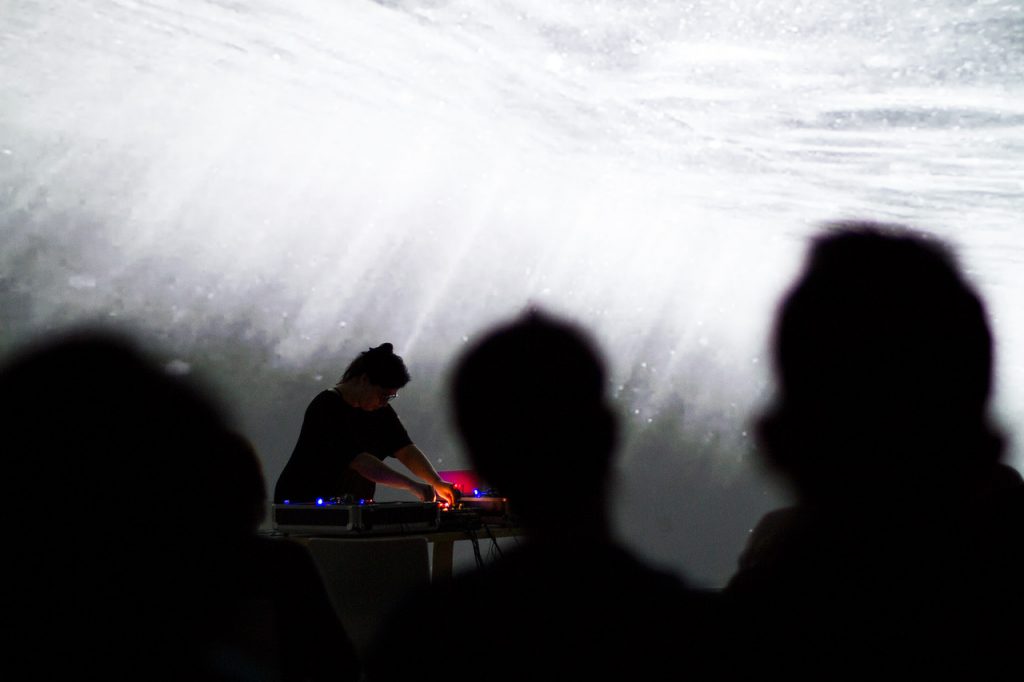
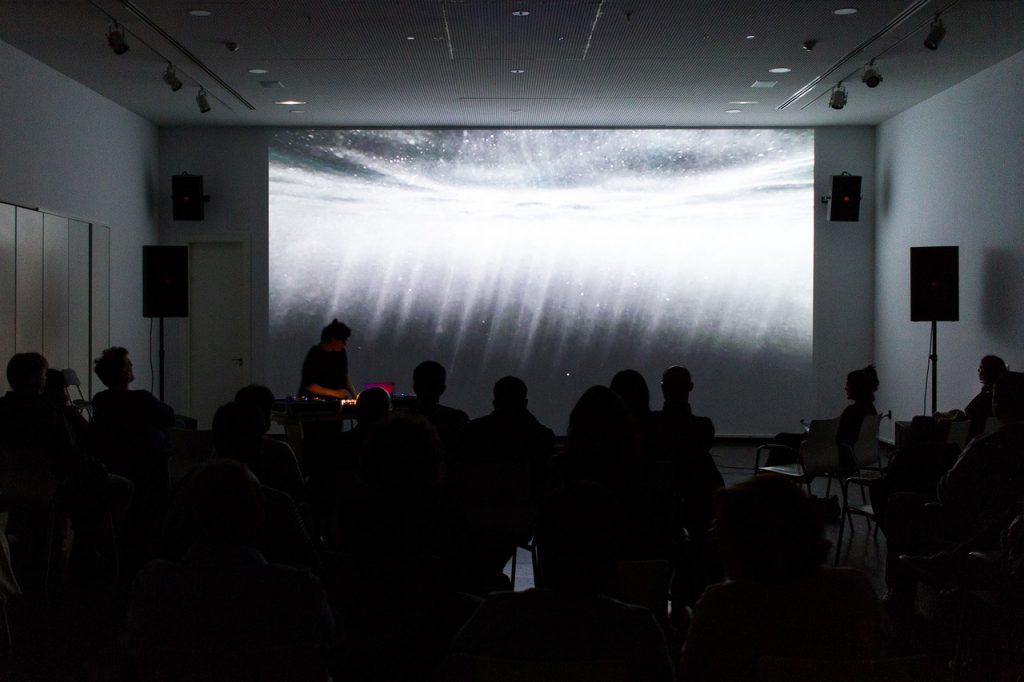
________________________________________________________________________________________________________________________________________
Aquatocene / Subaquatic audio – visual performance and lecture by Robertina Šebjanič at Kosmica festival, at Laboratorio Arte Alameda at Mexico City || photo by Kosmica archive:
________________________________________________________________________________________________________________________________________
The Aqautocene audio-visual performance, by Robertina Šebjanič, had guest Miha Ciglar joining in. The creative and exploratory work of Robertina Šebjanič is focusing on living systems with particular attention to the (under)water sonic environments, whereas Miha Ciglar deals with the development of novel instruments and the directional audio system that is used in the performance.
Performance at Kiblix festival was done with invited guest Miha Ciglar and Acouspade™Directional Speaker ||photo by Kibla || video by Tanja Grosman
________________________________________________________________________________________________________________________________________
The sound installation Aquatocene presents the compositions in the form of a continuous spheric loop using sound sources placed in different space points across the exhibition space.
________________________________________________________________________________________________________________________________________
Aquatocene / Subaquatic quest for serenity
Credits:
Artist (development / sound recording / sound editing): Robertina Šebjanič
Production support (2016 – 2017): Kibla, Bunker, Zavod Praksa, Piksel festival, 1.camp residency program at Roscoff Marine Station, Sektor
Special thanks to: Annick Bureaud, Miha Ciglar, Acouspade™Directional Speaker, MY studio- Yann Jaffiol, UR Institute, Slavko Glamočanin, PORTIZMIR#3, Miha Colner
Project was supported by the Ministry of Culture of the Republic of Slovenia and MOL – Department for Culture, Fondation Daniel et Nina Carasso
________________________________________________________________________________________________________________________________________
Aquatocene Vinyls I., II., II., released 2016
________________________________________________________________________________________________________________________________________
LIQUEFACTION an a-v performance
Robertina Šebjanič performs with Aquatocene vinyls and Carole Thibaud with her 16mm film recordings recorded during her residency at Roscoff Marine Station.
________________________________________________________________________________________________________________________________________
Sound installation and performance at Mladi Levi festival, Ljubljana 2016
video recap of all the festival 2016:
Author: Robertina Šebjanič
Performance: Robertina Šebjanič and Miha Ciglar
Technical support: : Slavko Glamočanin
Produced by: PRAKSA – Agencija za sodobno raziskovalno umetnost and Bunker, Ljubljana 2016
Local producer: Katarina Slukan Guest of the project: Miha Ciglar
Text form the catalogue of the performance during the Mladi Levi festival, Ljubljana, 2016:
Despite the broad availability of popular aquatic sounds, the vocalizations of whales and dolphins or the calming sloshing of waves, we aren’t really aware that the underwater soundscape is as rich as the one heard by terrestrial creatures above water. Aside from the fascinating diversity of marine sound, sonic pollution caused by humans is sadly already changing the soundscape of the waters and even the communication of its inhabitants. The creative and exploratory work of Robertina Šebjanič has been focusing on living systems, with particular attention to the exploration of (under)water fauna, whereas Miha Ciglar deals with the development of novel instruments in search of new possibilities for audio expression. Using hydrophones, Šebjanič captured the underwater sounds of various seas to prepare her installation, a subaquatic soundscape that will be joined by Ciglar’s audio performative interventions. Let us listen to the ocean, then, not under the anthropocentric guise that its sound is the splashing of water against rock, but hearkening, instead, deep underwater.
________________________________________________________________________________________________________________________________________________________________________________________________________________________________________________________________________________
Ready to Change International Conference: NEW POLITICAL MYTHOLOGIES AND ART
Robertina Šebjanič, Victoria Vesna & James K. Gimzewski: SUBAQUATIC SOUND SCAPE
http://www.bunker.si/eng/archives/8523
In the entrance hall of Stara mestna elektrarna, Robertina Šebjanič did set up her Aquatocene – Subaquatic Soundscape, an installation that immerses visitors in the underwater sounds of the ocean recoded by the artist using a hydrophone across different seas. With her project Robertina Šebjanič brushes aside the veil of anthropocentric certainty that cannot see (or hear) beyond its own world, presenting the wealth of sounds found below the surface of the sea, in many ways even richer than those heard above water.
At the conference was Robertina together with Victoria Vesna and James K. Gimzewski, illuminate subjects addressed by the installation, such as the problems of noise and sound pollution affecting the seas and oceans, as well as other factors of pollution, from the nano-level of various toxins and plastic particles to the macro-level of global situations threatening the seas in the age of Anthropocene.
________________________________________________________________________________________________________________________________________
________________________________________________________________________________________________________________________________________
Aquatocene / V iskanju podvodne tišine
Projekt spodbuja razmislek o vplivu človekovega delovanja na podvodni habitat ter o vzpostavitvi oziroma vzdrževanju varnih zvočnih okolij za živali živeče v morjih, jezerih ali rekah. Aquatocene / V iskanju podvodne tišine raziskuje fenomen hrupne in zvočne obremenitve podvodne zvočne krajine, katerega velik del povzroča človekova prisotnost v morskih habitatih. Robertina je tekom zadnjih let s pomočjo hidrofonov pridobila serijo podvodnih posnetkov. Zvočne kompozicije bodo predstavljene na LP vinilnih ploščah. Podvodni hrup je vseprisoten v svetovnih oceanih in morjih in ima velik vpliv na podvodno življenje in njegovo zvočno krajino. Industrijski in tehnološki posegi v zvočno pokrajino oceanov, ki jih povzročajo ladje, sonarji, zvočni topovi (uporabljajo se pri iskanju novih naftnih zalog) pomenijo velikansko obremenitev za občutljiv živalski svet. Povezujejo jih s številnimi škodljivimi posledicami, od nasedanja kitov do Lombardovega učinka, po katerem določene vrste postajajo vse glasnejše, saj lahko le tako preglasijo hrup iz ozadja, kar postopoma privede do povečane zvočne intenzivnosti celotnega habitata.
Posnetki so bili posneti na naslednjih lokacijah:
Egejsko morje – Izmir (TR) – 38°26’24.7″N 27°07’12.9″E
Jadransko morje – Dubrovnik (HR) – 42°38’26.5″N 18°06’20.4″E
Jadransko morje – Koper (SI) – 45°32’54.9″N 13°42’20.1″E
Atlantski ocean – Roscoff (FR) – 48°43’38.2″N 3°59’33.4″W
Severno morje – Bergen (NO) – 60°24’49.2″N 5°16’54.9″E
